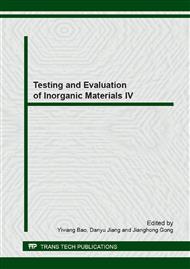[1]
Michelle L. Oyen, Robert F. Cook, A practical guide for analysis of nanoindentation data, Journal of the mechanical behavior of biomedical materials. 2(2009)396-407.
DOI: 10.1016/j.jmbbm.2008.10.002
Google Scholar
[2]
A.C. Fischer-Cripps, A review of analysis methods for sub-micron indentation testing, Vacuum. 58(2000)569-585.
DOI: 10.1016/s0042-207x(00)00377-8
Google Scholar
[3]
T. Wen, J.H. Gong, Z.J. Peng, Analysis of continuous stiffness data measured during nanoindentation of titanium films on glass substrate, Materials Chemistry and Physics. 125 (2011) 500–504.
DOI: 10.1016/j.matchemphys.2010.10.026
Google Scholar
[4]
J.H. Gong, Z.J. Peng, H.Z. Miao, Analysis of the nanoindentatio load–displacement curves measured on high-purity fine-grained alumina, Journal of the European Ceramic Society. 25 (2005) 649–654.
DOI: 10.1016/j.jeurceramsoc.2004.04.003
Google Scholar
[5]
T. SCHERBAN, D. PANTUSO, B. SUN, Characterization of interconnect interfacial adhesion by cross-sectional nanoindentation, International Journal of Fracture. 119/120(2003) 421–429.
DOI: 10.1023/a:1024931913643
Google Scholar
[6]
C. Heinrich, A.M. Waas, A.S. Wineman, Determination of material properties using nanoindentation and multiple indenter tips, International Journal of Solids and Structures. 46 (2009) 364–376.
DOI: 10.1016/j.ijsolstr.2008.08.042
Google Scholar
[7]
T. Wen, J.H. Gong, Z.J. Peng, Determination of the thickness of titanium films on glass substrate by nanoindentation tests, Journal of Materials Research. 26 (2011) 353-356.
DOI: 10.1557/jmr.2010.56
Google Scholar
[8]
M. Toparlia, N.S. Koksal, Hardness and yield strength of dentin from simulated nanoindentation tests, Computer Methods and Programs in Biomedicine. 77(2005)253—257.
DOI: 10.1016/j.cmpb.2004.11.003
Google Scholar
[9]
Lin Huang, Wenlong Yao, Amiya K, Improved Mechanical Behavior and Plastic Deformation Capability of Ultrafine Grain Alumina Ceramics, J. Am. Ceram. Soc. 95(2012)379–385.
DOI: 10.1111/j.1551-2916.2011.04951.x
Google Scholar
[10]
P. Davies, L. Sohier, J. -Y. Cognard, Influence of adhesive bond line thickness on joint strength, International Journal of Adhesion & Adhesives. 29 (2009) 724–736.
DOI: 10.1016/j.ijadhadh.2009.03.002
Google Scholar
[11]
Y. Zhang, M. Allahkarami, J.C. Hanan, Measuring residual stress in ceramic zirconia–porcelain dental crowns by nanoindentation, J. Mechanical Behavior of Biomed. Mater. 6(2012)120-127.
DOI: 10.1016/j.jmbbm.2011.11.006
Google Scholar
[12]
Bharat Bhushan, Nanoscale characterization of human hair and hair conditioners, Progress in Materials Science. 53(2008)585–710.
DOI: 10.1016/j.pmatsci.2008.01.001
Google Scholar
[13]
T. Chraska, A.H. King, C.C. Berndt, On the size-dependent phase transformation in nanoparticulate zirconia, Materials Science and Engineering. A286(2000) 169–178.
DOI: 10.1016/s0921-5093(00)00625-0
Google Scholar
[14]
S. Habelitz, G. W, Marshall Jr, Nanoindentation and storage of teeth, J. Biomech. 35(2002) 995–998.
Google Scholar
[15]
Alireza Sadr, Yasushi Shimada, Hongbing Lu, The viscoelastic behavior of dental adhesives: A nanoindentation study, Dental materials. 25(2009)13–19.
DOI: 10.1016/j.dental.2008.05.001
Google Scholar
[16]
A. Krell, S. Schädlich, Nanoindentation hardness of submicrometer alumina ceramics, Materials Science and Engineering. A307(2001)172–18.
DOI: 10.1016/s0921-5093(00)01818-9
Google Scholar
[17]
J.H. Gong, Z.J. Peng, H.Z. Miao, Description of the unloading behavior of Berkovich nanoindentation, Key Engineering Materials. 280-283(2005) 1757-1760.
DOI: 10.4028/www.scientific.net/kem.280-283.1757
Google Scholar
[18]
Z.H. Li, J.H. Gong, Z.J. Peng, Indentation size effect in the nanohardness of soda-lime glass, Key Engineering Materials. 280-283(2005)1659-1662.
DOI: 10.4028/www.scientific.net/kem.280-283.1659
Google Scholar
[19]
S. Cheng, J.H. Gong, Z.T. Zhang, Study of LSGM slurry for gel-tape casting, Key Engineering Materials. 280-283(2005)751-752.
DOI: 10.4028/www.scientific.net/kem.280-283.751
Google Scholar
[20]
G.G. Zhao J.H. Gong, An improved work-of-indentation approach for the determination of hardness from nanoindentation tests, Rare Metal Materials and Engineering. 34(2005) [Sp. 1] 371-374.
Google Scholar
[21]
J.H. Gong, Determination of the load-independent hardness by analyzing the peak-load-dependence of the initial unloading slope in nanoindentation, Key Eng. Mater. 280-283 (2005)1761-1764.
DOI: 10.4028/www.scientific.net/kem.280-283.1761
Google Scholar


